Last week, we chatted briefly about variegated threads. I’ve talked about using variegated threads for hand embroidery before, and at the end of this article, I’ll link to a few previous discussions and projects where variegated embroidery threads have played a role.
In a two-part series of articles, I’m going to share with you four different ways you can use variegated threads in hand embroidery, each way giving a slightly different result to your finished stitching.
In Part I of this series, we’ll look at the first two simple ways you can use variegated threads. They require no planning or forethought and no special approach. In Part II of the series, we’ll look at two different ways to use variegated threads, equally easy, but which require a little more planning or forethought.
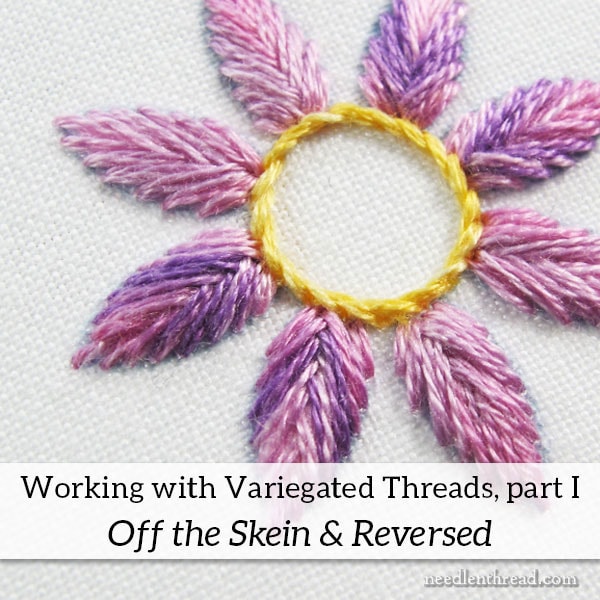
One of the advantages of using a variegated thread – that is, a thread that features different colors or shades in patches or streaks – is that you have, within the one thread, some variety. You can purchase and stitch with just the one thread, without changing colors or shades as you go, and still achieve a multi-colored (or shaded) element.
So in a sense, variegated threads can make embroidery with multiple colors or shades easier and more economical.
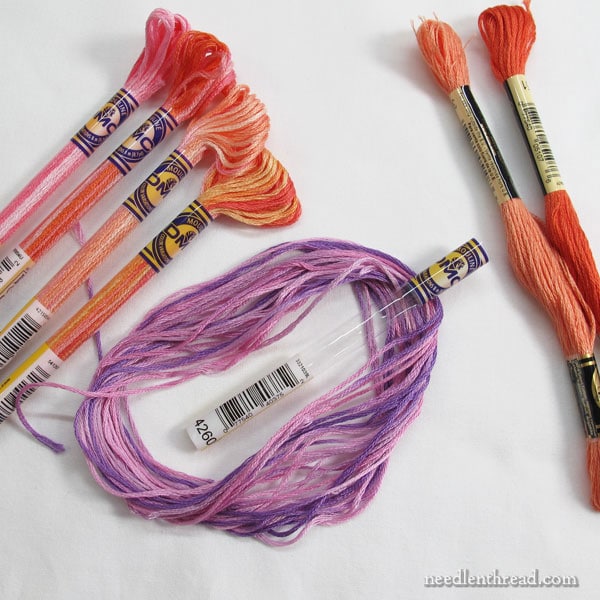
The supplies I’m using in this series of articles are pretty simple! I’ll be stitching on white cotton fabric, using DMC Variations embroidery floss, as well as one DMC solid.
I’ll be stitching each element with three strands of floss, using a #7 crewel needle. My fabric’s set up in a wooden hoop, and I’ve got a pair of sharp, small embroidery scissors on hand.
The elements are all identical – simple flowers made of eight petals and worked in fishbone stitch, starting at the top (12 o’clock) petal, and working clockwise around the flower. Each petal begins at the outer tip and is stitched from tip to base.
If you are unsure of how to work the fishbone stitch, you can find a tutorial for fishbone stitch here.

For the samples in the series, I’m going to use the same color number of Variations – specifically, 4260, which is a pink to purple variegated thread. It includes elements light pink, dark pink, soft pink-purple, and a darker purple.
All those colors move into each other gradually, so that the shade deepens along the thread until it begins to switch to the new color.
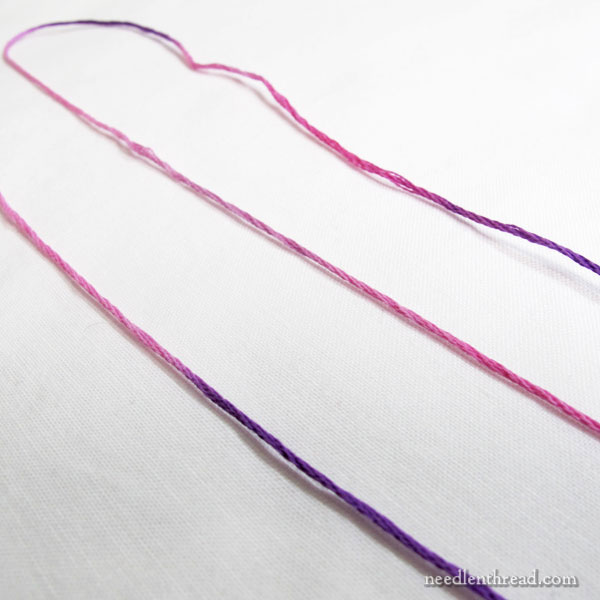
I find it useful, before stitching with a variegated thread, to un-skein it and get a good look at the sequence of the color changes. That way, I know what I’m going to be working with and I know what’s coming up as I stitch.
I can also get a good idea of which shades I want to emphasize and which shades I might want to play down a bit.
For the first sample, I’m using the thread straight off the skein, with no plan and no consideration of the way the colors fall.
I simply cut a length of the thread straight off the skein and separated out three strands to stitch with.
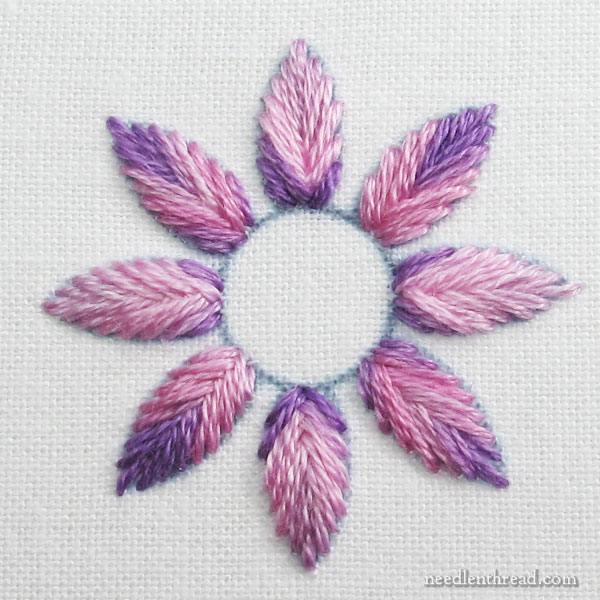
With the first sample, using the variegated thread straight off the skein, I was able to stitch three petals before changing the thread. I started at the tip of the 12 o’clock petal and moved to each new petal, starting at the tip again.
You can see how the second petal to the right of the top center carries the purple from the base of the first petal to the tip of the second.
This is ok, if you want that random placement. All the way around the flower, in fact, the darker purple is fairly patchy and it shows up mostly at the tip or the base of the petal. It is just happenstance that there is no dark purple patch in the middle of any petal.
Overall, it looks fine, but it’s evident that there’s no planning – all the colors fall rather randomly, and the switch between shades is somewhat harsh, even though the transitions on the thread come across as slightly more subtle.
Remember, your thread has to travel on the back of the fabric, too, when working a stitch, so sometimes the transitions on variegated threads are less subtle on a stitched element because the transitions might actually happen on the back of the fabric during the normal movement of making the stitch.
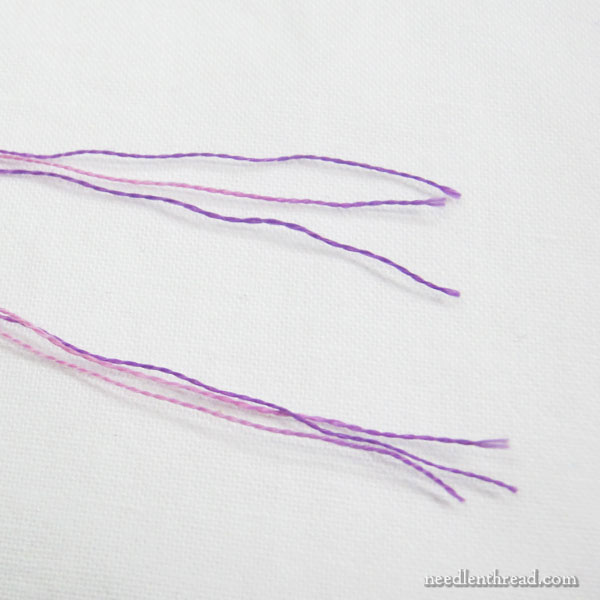
For the second sample, I cut my thread straight from the skein, and then separated out three strands.
I took one of the three strands and reversed its direction. You can see in the photo above that the two ends of the group of three threads have one thread that features a different color sequence. This is because I reversed the direction of the thread, so the color sequence in the reversed thread will not line up with the color sequence in the other two threads.
This should result in a slightly softer look to the whole flower, with (hopefully) a somewhat heathered effect. That is, the color should be a little sketchy, with flecks of color coming across here and there, rather than patchy chunks of color throughout.
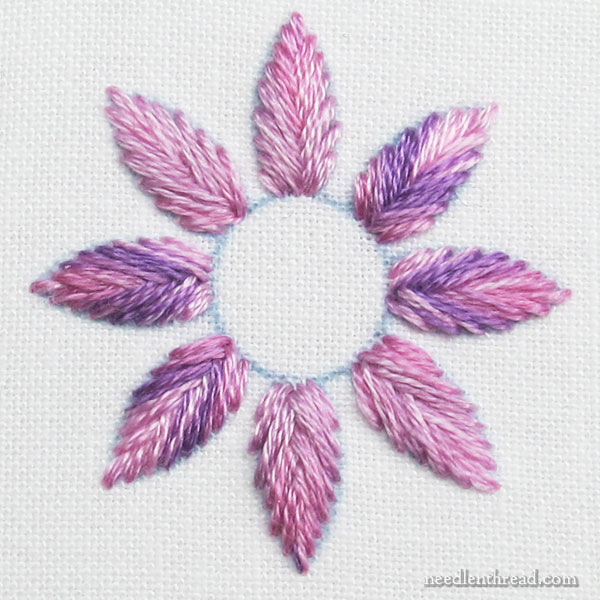
Here is the resulting flower. There are certainly fewer patches of solid purple, and the petals sporting the mostly-pink color ways are definitely not as noticeably variegated. They look slightly heathered, with flecks of color rather than larger patches of color.
When working with two strands of variegated floss, switching the direction of one strand will result in a much more heathered look to the stitching. With three strands, the softer heathered look is perhaps not as noticeable, but it does soften the variegated layout.
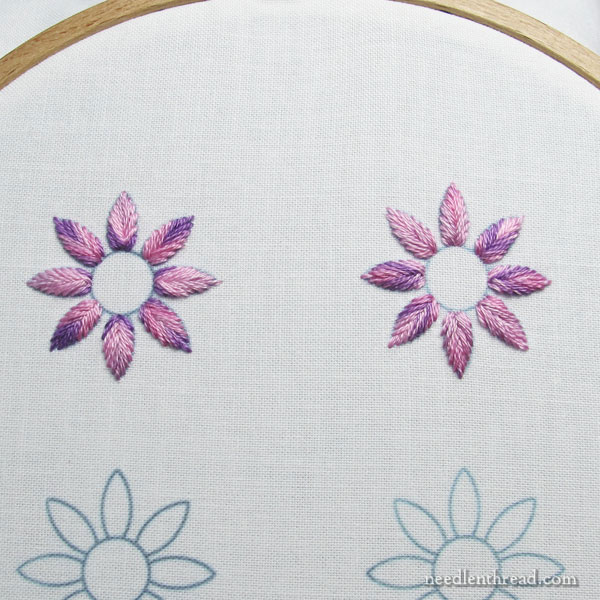
Above, you can see the two flowers together. The flower on the left was stitched with the variegated floss straight off the skein. The flower on the right had one strand of variegated floss reversed.
Notice that the colors are more patchy and distinct in the flower on the left, and on the right, they are slightly sketchier, with softer transitions.
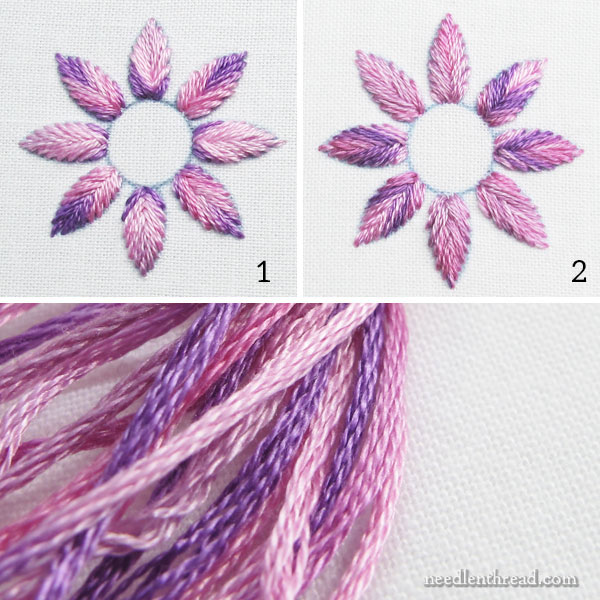
The colors in the skein of Variations are well represented in both flowers, but neither flower displays any controlled idea of color layout, or any real consistency of any one color throughout every portion of every petal. And that’s fine! That’s the nature of working with variegated floss with these two approaches.
In the next article, we’ll look at what happens when we add a little forethought to stitching and a little control to the threads.
Read More about Stitching with Variegated Threads
Needle Arts Class: Color Control – Here, you’ll see some demonstrations of color control with variegated threads during a high school needle arts class I taught a while back.
DMC Coloris & Corresponding Solids – This article includes a PDF printable for corresponding solid DMC colors for Coloris as well as for Variations. Scroll towards the end of the article for the links for the PDFs.
Overdyed Threads: Your Take? – In this article, I presented Colour Complements before it was Colour Complements! I also asked for your take on overdyed threads. Read the comments – there’s always good information from the wider Needle ‘n Thread community in the comments!
Variegated Embroidery Thread & Ribbed Wheels – This article focuses on using variegated thread to stitch tiny ribbed wheels on the side of a monogram. You’ll see how the subtle color change enhances the elements on the monogram, without having to switch out colors,
Two Stitches, Two Threads, and Done in One Day – The sample in this article features variegated floss with long and short stitch as a filling. It worked well, achieving a subtle pink-lemonade variety in colors without having to switch threads.
Simple Straight Stitched Flowers – Take a simple straight stitch flower like the ones featured in this article and stitch them with variegated threads, and you’ll have an instant floral success!
This Coloris Kaleidoscope project demonstrates how you can combine variegated and solids to create a controlled use of variegated color.